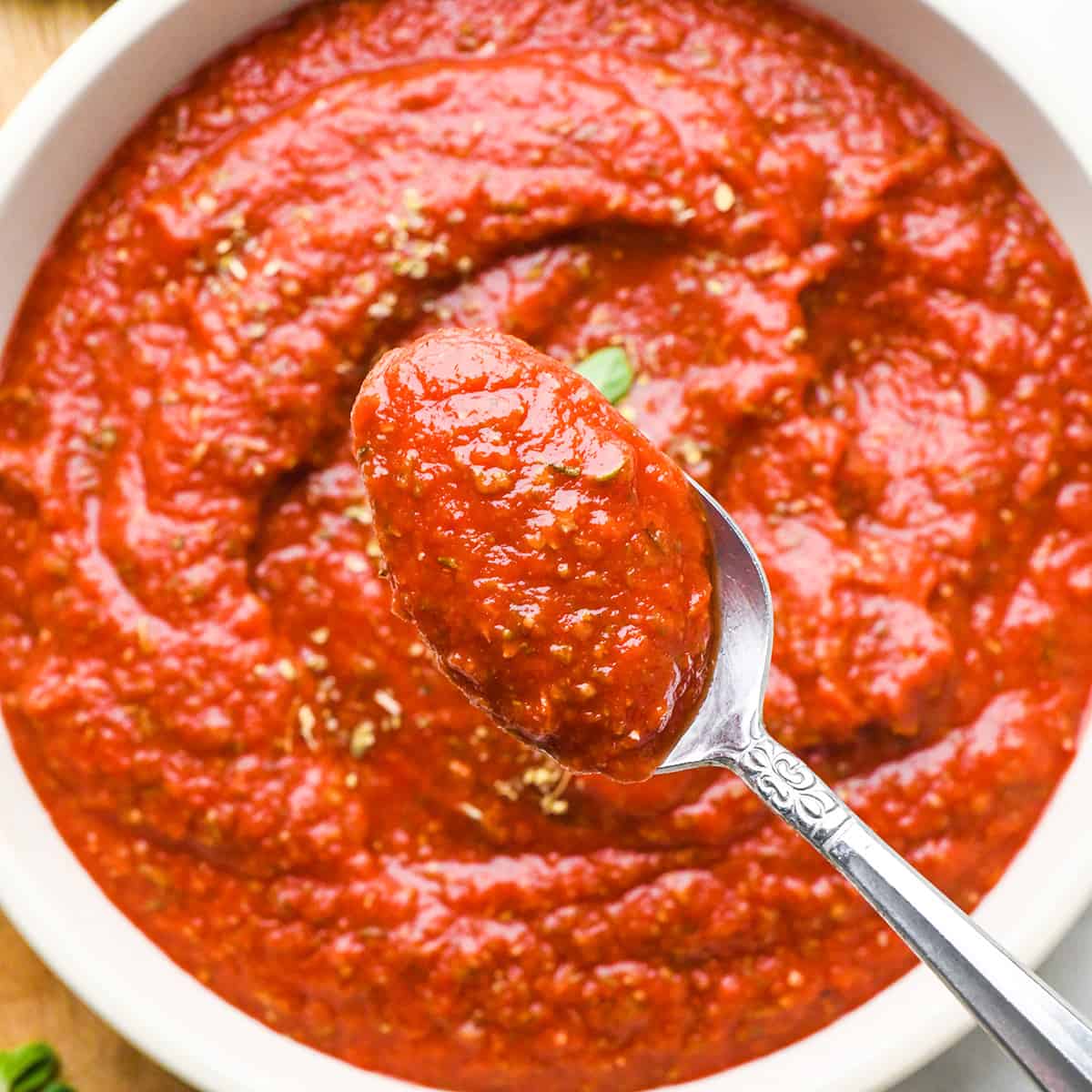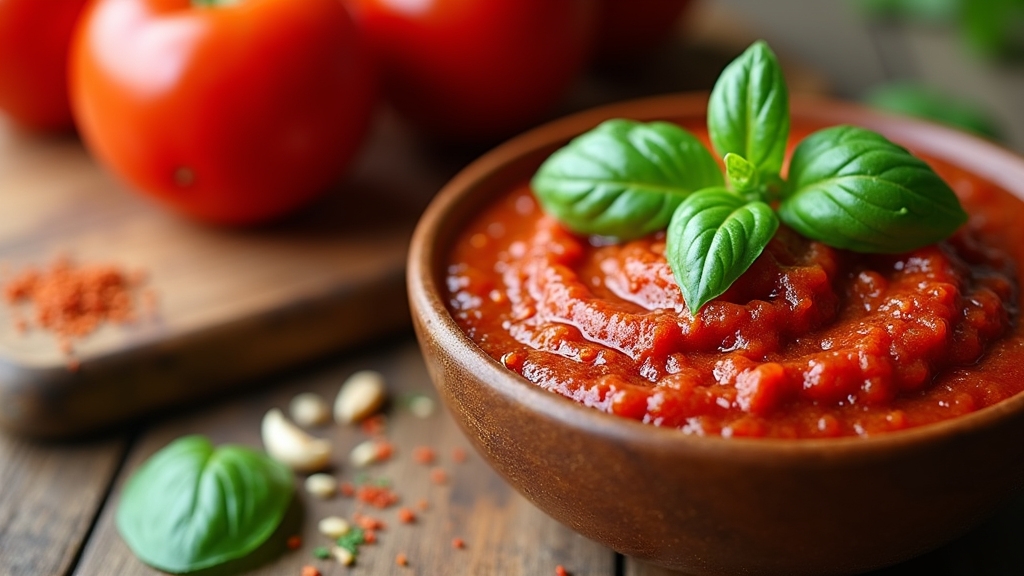I’ve got a delicious and easy pizza sauce recipe that’ll elevate your homemade pizza! Simply mix a can of crushed tomatoes with olive oil, dried oregano, and basil. For a little kick, add minced garlic. Simmer the mixture to develop rich flavors, then blend it to your desired consistency. This versatile sauce not only tastes amazing but is packed with nutrients too. Stick around, and I’ll share some tips on storage and reheating for maximum enjoyment!
History
When I think about the history of pizza sauce, I can’t help but be fascinated by its roots, which trace back to ancient civilizations. The earliest versions of tomato sauce emerged in the 16th century, but the concept of a sauce to complement bread has ancient origins. Romans and Greeks used various herb-infused oils and sauces, laying the groundwork for what we now recognize. As pizza spread, regional variations blossomed. In Naples, we see the classic Marinara, while in Sicily, a more robust, chunky style takes center stage. Each region’s unique ingredients and preparation methods reveal how culture and climate influence flavor. It’s incredible to think how this simple sauce has evolved, reflecting the creativity and diversity of culinary traditions.
Recipe
Making your own pizza sauce can elevate your homemade pizza to a whole new level. This recipe is simple yet flavorful, allowing the natural ingredients to shine through and complement your choice of toppings perfectly. Whether you prefer a classic Margherita or a loaded supreme, this sauce serves as the ideal base that enhances every bite.
Using fresh herbs and quality tomatoes can greatly impact the taste of your pizza sauce. You can easily customize it to your liking by adjusting the seasoning or adding ingredients such as garlic or onion for an extra kick. This versatile sauce can also be stored in your refrigerator or freezer, making it a convenient option for your future pizza nights.
Ingredients:
- 1 can (28 ounces) crushed tomatoes
- 2 tablespoons olive oil
- 1 teaspoon dried oregano
- 1 teaspoon dried basil
- 1 teaspoon sugar
- 1/2 teaspoon salt
- 1/4 teaspoon black pepper
- 2 cloves garlic, minced (optional)
- 1 tablespoon fresh parsley, chopped (optional)
Instructions:
In a medium saucepan, heat the olive oil over medium heat. If using, add the minced garlic and sauté for about 30 seconds until fragrant, being careful not to burn it. Then, pour in the crushed tomatoes and stir in the oregano, basil, sugar, salt, and pepper. Bring the sauce to a simmer, reduce the heat to low, and let it cook uncovered for about 15-20 minutes, stirring occasionally, until it thickens slightly and the flavors meld together.
Extra Tips:
For a smoother sauce, you can blend it using an immersion blender or a countertop blender after cooking. Additionally, feel free to adjust the spices to suit your taste; adding red pepper flakes can give it a nice heat, while a splash of balsamic vinegar can enhance the sweetness. If you’re making a large batch, this sauce freezes well, so you can always have some on hand for your next pizza night!
Cooking Steps
Let’s get started on making the perfect pizza sauce! I’ll guide you through each step, beginning with preparing fresh tomatoes and simmering them with a delightful blend of herbs and spices. By the end, you’ll have a rich, flavorful sauce that’s sure to elevate your pizza game.
Step 1. Prepare Fresh Tomatoes First
To kick off your pizza sauce, preparing fresh tomatoes is essential for achieving that vibrant flavor. I love using a mix of fresh tomato varieties like Roma, San Marzano, and heirloom for their unique tastes and textures. Start by washing them thoroughly, then choose your tomato preparation techniques. You can blanch them to easily remove the skins, or simply chop them raw for a chunkier sauce. Next, core and seed the tomatoes to reduce excess liquid, ensuring a thicker consistency. As you work, savor the fragrant aroma and rich color; this is where the magic begins! By using fresh tomatoes, you’ll elevate your sauce to a whole new level, setting the stage for a truly unforgettable pizza experience.
Step 2. Simmer With Herbs and Spices
As the fresh tomatoes simmer gently on the stovetop, the magic truly begins with the addition of herbs and spices that awaken the sauce’s flavors. I love experimenting with different herb combinations, like basil, oregano, and thyme, to create a fragrant bouquet that complements the tomatoes beautifully. When it comes to spice levels, I often start with a pinch of red pepper flakes for a subtle kick, adjusting to taste as the sauce develops. The key is to let these ingredients meld together, allowing the heat to coax out their natural oils and essence. Stir occasionally, and soon you’ll have a rich, aromatic sauce that’s bursting with flavor, ready to elevate any pizza creation.
Step 3. Blend Until Smooth
Now it’s time to transform your simmered sauce into a velvety masterpiece. Blending is where the magic happens, giving your sauce a smooth consistency that elevates its flavor balance. Here’s how I do it:
- Choose your blender: Whether it’s an immersion blender or a traditional one, pick what suits you.
- Cool slightly: Let the sauce cool for a few minutes to avoid splatters.
- Blend in batches: If your sauce is abundant, blend in smaller portions for even smoothness.
- Check the texture: After blending, verify it’s silky; if not, blend a bit longer.
With each blend, I’m amazed at how the flavors meld together, achieving that perfect harmony. Enjoy the transformation!
Step 4. Taste and Adjust Seasoning
How can you guarantee your pizza sauce hits all the right notes? It’s all about tasting and adjusting the seasoning. Start by taking a small spoonful of your sauce; this is where the magic begins. You’ll want to assess the seasoning balance—does it need more salt, or perhaps a touch of sugar to counter the acidity? A sprinkle of dried oregano or a dash of crushed red pepper can elevate the sauce, offering that flavor enhancement you crave. Remember, it’s a journey! Keep tasting and adjusting until it sings. Don’t be afraid to experiment; every ingredient plays a role in creating that perfect blend. With a little patience, you’ll craft a sauce that makes your pizza truly unforgettable.
Step 5. Add Olive Oil Drizzle
After perfecting the seasoning in your pizza sauce, it’s time to elevate its richness with a drizzle of olive oil. This step not only enhances flavor but also brings a host of olive oil benefits, including heart-healthy fats. Here’s how I do it:
- Choose Quality: Opt for extra virgin olive oil, ensuring a robust flavor.
- Warm It Up: Slightly warming the oil can amplify its aroma and taste.
- Drizzle Techniques: Use a spoon or a squeeze bottle for precision; aim for a gentle, even drizzle.
- Taste Test: After drizzling, give your sauce a quick taste—adjust if necessary.
This simple addition transforms your pizza sauce, creating a luxurious depth that’s hard to resist!
Nutritional Guide
While crafting a delicious pizza sauce, it’s essential to contemplate its nutritional value to enhance your meal’s overall healthiness. I’ve found that using fresh ingredients not only boosts flavor but also provides impressive nutritional benefits. For instance, tomatoes are rich in antioxidants, while garlic offers anti-inflammatory properties. If you’re looking for ingredient alternatives, consider using herbs like oregano or basil, which add depth and promote heart health.
Here’s a quick guide to help you visualize the nutritional aspects:
| Ingredient | Nutritional Benefit |
|---|---|
| Tomatoes | High in Vitamin C & antioxidants |
| Garlic | Anti-inflammatory & immune support |
| Olive Oil | Heart-healthy fats |
| Fresh Herbs | Rich in vitamins & minerals |
Final Thoughts
As I reflect on the journey of crafting the perfect pizza sauce, it’s clear that each ingredient plays a vital role in creating a rich, flavorful experience. Exploring various sauce variations can elevate your pizza game to new heights. Whether you prefer a classic marinara or a spicy arrabbiata, the possibilities are endless!
Here are some storage tips to keep your sauce fresh and delicious:
- Refrigerate: Store your sauce in an airtight container for up to a week.
- Freeze: Portion it into ice cube trays for easy access to small amounts.
- Label: Always date your containers to track freshness.
- Reheat: Gently warm your sauce on the stovetop to preserve its flavors.
Happy saucing!
Frequently Asked Questions
Can I Use Fresh Tomatoes Instead of Canned for the Sauce?
I love using fresh tomatoes. They bring vibrant flavor and nutrients. When selecting, look for firm, ripe ones with rich color. Trust me, the benefits of fresh tomatoes will elevate your dish!
How Long Can I Store Homemade Pizza Sauce?
Picture your vibrant homemade sauce, bubbling with flavor, stored away. I’ve found it lasts about a week in the fridge, but with proper storage tips, you can extend its shelf life up to three months in the freezer.
Can I Freeze Pizza Sauce for Later Use?
Absolutely, I can freeze pizza sauce for later use! I use airtight sauce containers and smart freezing techniques to preserve flavor, making it easy to enjoy homemade goodness whenever I crave it.
What Herbs Work Best in Pizza Sauce?
When I make sauce, I love adding oregano for its robust flavor and health benefits. Experimenting with different basil varieties elevates the dish, giving it a fresh, aromatic twist that excites my taste buds every time.
Is It Possible to Make Pizza Sauce Spicy?
Absolutely, I love adding spicy ingredients to kick up the flavor! Whether it’s crushed red pepper or jalapeños, adjusting heat levels can transform any sauce. Experimenting with different spices keeps things exciting and unique every time!
Conclusion
As I take a moment to savor the rich, tangy flavor of homemade pizza sauce, I can’t help but feel like I’ve captured a piece of culinary history in my kitchen. This simple recipe transforms fresh ingredients into a vibrant red masterpiece, perfect for elevating any pizza night. So, roll up your sleeves, release your inner chef, and whip up this sauce that not only tantalizes the taste buds but also warms the heart with every bite.

Pizza Sauce Recipe
Ingredients
Equipment
Method
- Sauté Garlic: Heat olive oil in a saucepan over medium heat. Add minced garlic and sauté for 30 seconds until fragrant (avoid browning).
- Add Tomatoes: Pour in crushed tomatoes, stirring to combine.
- Season: Add oregano, basil, salt, pepper, red pepper flakes (if using), and sugar. Stir well.
- Simmer: Reduce heat to low and let the sauce simmer for 8-10 minutes, stirring occasionally.
- Blend (Optional): For a smoother sauce, blend with an immersion blender or transfer to a countertop blender.
- Cool & Use: Allow the sauce to cool slightly before spreading on pizza dough. Store leftovers in an airtight container for up to 1 week or freeze for 3 months.
Notes
- No-Cook Option: Skip simmering for a fresher, chunkier sauce—just mix all ingredients and use immediately.
- Variations: Add 1 tbsp tomato paste for thickness or ½ tsp balsamic vinegar for depth.
- Storage: Freeze in ice cube trays for portioned use.

